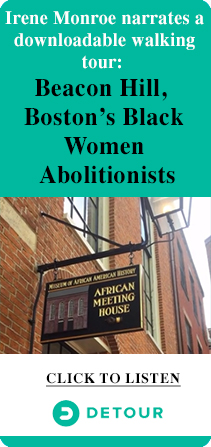This Easter, like all my Christian sisters and brothers, I long to celebrate the resurrection and new life. As a child of the Black Church, I long to hear on Easter morning the inimitable way that black gospel choirs sing my favorite hymn, “Because He Lives.” Yet as a lesbian, it’s not always easy to know where I can worship and not have to leave my sexual orientation at the door.
I recently asked Mickey N. Medlicott, a lesbian from New Jersey active in the welcoming church movement, how she understands the meaning of the cross for LGBT people in these times. She said: “The cross is always with us LGBT people. Sure, I can see and sometimes feel the light, but I never feel like I really arrive at the resurrection. Just when I feel comfortable in a job — to let a little of myself out, to let my guard down a little — someone will tell a gay joke, and I am forced to focus on the cross again. Trading `How was your day?’ stories with my partner sometimes leads to lessons on how little things have changed. It makes us cautious, fearful, and makes us live a certain way to avoid ending up on the cross ourselves.”
Despite the centrality of the cross within our tradition, many Christians pay little attention to the reasons for Jesus’ death and the systems of oppression that brought it about. This is tragic, since the forces that crucified Jesus on Good Friday have everything to do with the physical, spiritual, and emotional violence faced by marginalized people today.
Two thousand years ago, Jesus was unquestionably a threat to the social and political status quo. Viewed as a religious threat because of his iconoclastic views and practice of Jewish law, and as a political threat to the Roman government because of his popularity among the poor and oppressed, Jesus was nailed to a cross, an attempt by those in power to eliminate him.
Today, we live in a world where some individuals feel free to re-enact such a crucifixion, to destroy any whose existence threatens their own way of life. We’ve seen a recent rise in social intolerance and hate crimes, the worst since McCarthy’s witch hunts and the lynching of 14 year-old Emmett Till in the 1950s.
In June of 1998, the remote east Texas town of Jasper consumed the nation’s attention because of a heinous crime against a 49 year-old vacuum cleaner salesman named James Byrd, Jr. Walking home after a party one night, Byrd was offered a ride by some passersby. Little did he know that he would soon be chained by his ankles to the back of a pick-up truck and dragged to his death — because he was black.
Later that same year, after an explosion of ads in major newspapers from right-wing Christian “ex-gay” ministries, we heard the deadly news from another remote place: Laramie, Wyoming. This time, the victim was a 21 year-old first-year college student named Matthew Shepard. Under the guise of friendship, two men lured Shepard from a tavern, then bludgeoned him with their rifles and tethered him to a rough-hewn wooden fence, like a hunting trophy — because he was gay.
These modern-day crucifixions — one because of race, the other due to sexual orientation — raise serious questions about the classic Christian understanding of the cross as the locus of God’s atonement for human sin. For marginalized persons who want to avoid hanging on their own crosses, questions of how we understand Jesus’ crucifixion are not mere theological conundrums, but matters of life and death.
Within Christian tradition, the cross has too often been used to justify suffering and abuse, especially in the lives of the oppressed. The image of Jesus as the “suffering servant” has served to ritualize suffering as redemptive. While suffering points to the need for redemption, suffering in and of itself is not redemptive. Furthermore, the belief that undeserved suffering is to be endured through faith can encourage the powerful to be insensitive to the suffering of others and forces the less powerful to be complacent to their suffering — maintaining the status quo.
It is sometimes said in the church that “Jesus died for our sins.” Such language masks the reality that Jesus died because of our sins — our intolerance, our hatred, our violence. Jesus’ suffering on the cross because of these sins should not be seen as redemptive any more than the suffering of African-American men dangling from trees in the South during Jim Crow America. The lynchings of African-American men in this country were not restitution for the sins of the Ku Klux Klan, but a result of those sins.
As many liberation theologians have pointed out (whether they be feminist, womanist, African American, or lesbitransgay), the cross can be a valuable lens to examine the connections between Jesus’ suffering and the suffering of marginalized people today. The same abusive institutions and systems of domination at work in Jesus’ day now shape our current reality.
Suffering is an ongoing cycle of abuse that remains unexamined and unaccounted for. If we unmask the powers that create suffering, the powers that led Christ to the cross, we begin to see they are manifest in our everyday lives in systems of racism, sexism, classism, and heterosexism. Because the cross reveals how suffering victimizes the innocent and marginalized, it can extend to us all a promise of liberation.
When the Christian community looks to the cross, we must see not only Jesus, but the many other faces of God that are crucified with him today. In so doing, we deepen the church’s solidarity with all who suffer; those who are Christ in our midst.



